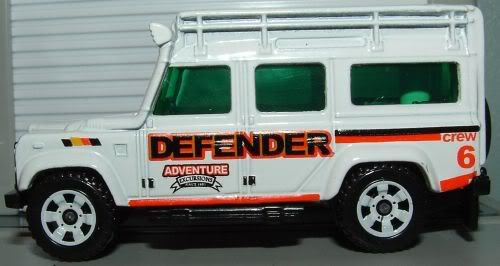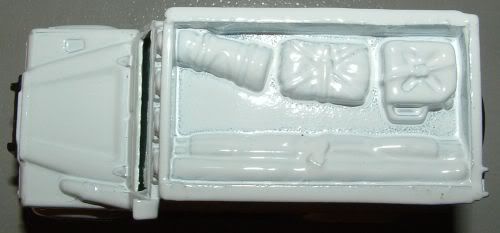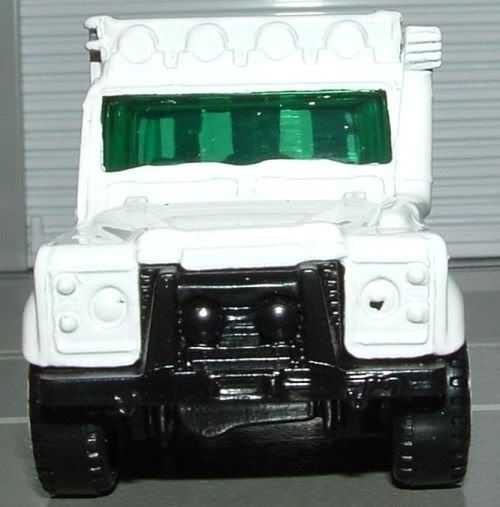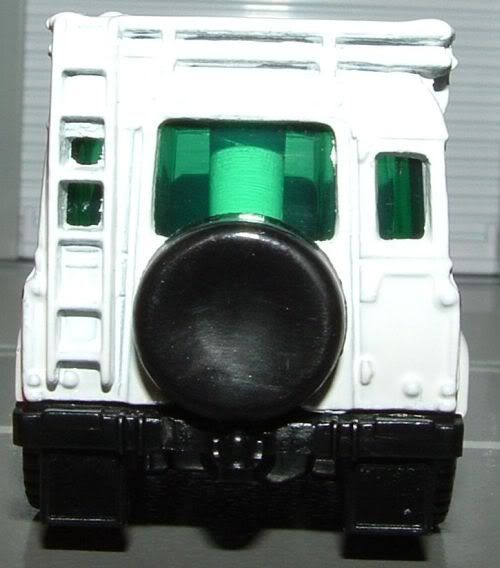
A blog focusing on 1/64 diecast from such popular brands as Hot Wheels, Matchbox, Johnny Lightning, M2 Machines, GreenLight, Tomica, Yat Ming, Majorette, MotorMax, Siku, Corgi, Guisval, Playart, Ertl, Zylmex, Racing Champions, & many more. Swifty's Garage features a daily Car Of The Day and news updates from your favorite brands!
Wednesday, October 5, 2011
SUV Of The Day: October 5, 2011
Today's car of the day is Matchbox's 1997 Land Rover Defender 110.
The Land Rover Defender (initially called the Land Rover Ninety and Land Rover One Ten) is a British four wheel drive off-road utility vehicle developed from the original Land Rover Series launched in 1948.
The model was introduced in 1983 as the Land Rover Ninety and the Land Rover One Ten, the numbers representing the wheelbase in inches. The number was spelt out in full in advertising and in handbooks and manuals, and the vehicles also carried badges above the radiator grille which read "Land Rover 90" or "Land Rover 110", with the number rendered numerically. The Ninety and One Ten replaced the earlier Land Rover Series, and at the time of launch, the only other Land Rover model in production was the Range Rover.
In 1989, a third model was brought out by Land Rover to be produced in parallel with the other two: the Land Rover Discovery. To avoid possible confusion, from 1991 the Ninety and the One Ten were renamed the Defender 90 and Defender 110. These carried front badges that say "Defender", with a badge on the rear of the vehicle saying "Defender 90" or "Defender 110". The current model, from 2007, still has the space above the radiator for the badge, but this is simply blank, and they have "Land Rover" spelt out across the leading edge of the bonnet in raised individual letters. At the rear is a new '"Defender" badge with an underlining "swoosh". On these current models there are no badges defining the wheelbase model of the vehicle.
The 127-inch (3,226 mm) wheelbase Land Rover 127 available from 1985 was always marketed with the name rendered numerically. Following the adoption of the Defender name, it became the Defender 130, although the wheelbase remained unchanged.
North American Specification (NAS) Defenders sold between 1993 and 1997 said only "Land Rover" with no "90" or "110" numeric designation.
For more information and pictures of the real car please visit: Land Rover Defender 110
When this one joined the Matchbox range in the 2000s, I admit I was confused. It seemed like an odd choice to offer a 1997 model as a brand new casting when the real vehicle was almost ten years old. Now it makes sense because the Defender is still in production, but 1997 was the last year they were sold in the USA. In this case, this one has been modified for serious off-road use as well.
In 1993 Land Rover launched the Defender in the North American (i.e. the United States and Canada) market. Although the Range Rover had been sold there since 1987, this was the first time utility Land Rovers had been sold since 1974. To comply with the strict United States Department of Transportation regulations, ranging from crash safety to lighting, as well as the very different requirements of American buyers, the North American Specification (NAS) Defenders were extensively modified. The initial export batch was 525 Defender 110 County Station Wagons. 500 to the United States and 25 to Canada. They were fitted with the 3.9 litre V8 petrol engine and 5-speed manual transmission. All the vehicles were white (except one specifically painted black for Ralph Lauren). They sported full external roll-cages and larger side-indicator and tail-lights. All were equipped with the factory-fitted air conditioning system.
For the 1994 and 1995 model year Land Rover offered the Defender 90, fitted with a 3.9 litre V8 engine and a manual transmission which was clearly intended to compete with the Jeep Wrangler. Initially, the Defender 90 was only available as a soft-top, but later version was offered with a unique, removable, fibre-glass roof panel or regular Station Wagon hard-top.
In the final year of US production the engine was improved, designated 4.0 and mated to a 4 speed automatic transmission. In 1998 regulations changed to require the fitting of airbags for both front seat passengers in all vehicles, as well as side door impact requirements. The Defender could not be fitted with these without major modifications, which given the small numbers of NAS vehicles sold in relation to Land Rover's global sales, were not economically viable. Land Rover retired its utility vehicles at the end of 1997 to focus on its more upmarket Discovery and Range Rover models, as well as the newly launched Freelander.
Subscribe to:
Post Comments (Atom)






No comments:
Post a Comment